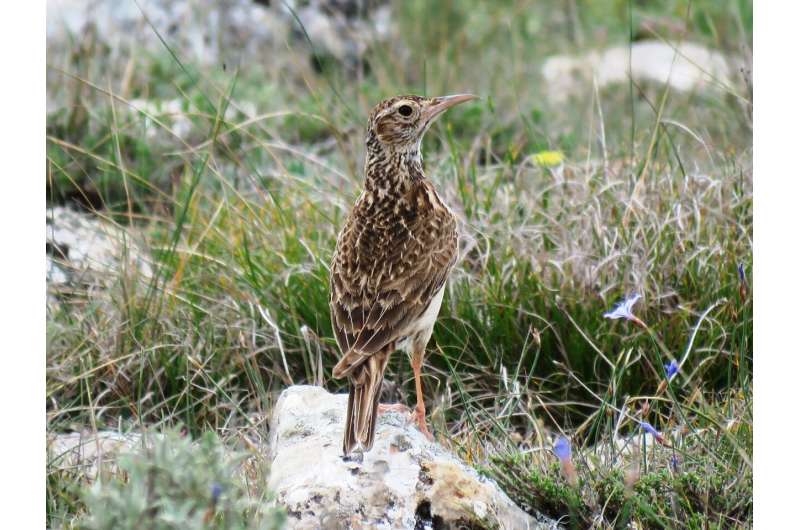This article has been reviewed according to Science X's editorial process and policies. Editors have highlighted the following attributes while ensuring the content's credibility:
fact-checked
trusted source
proofread
Endangered Dupont's lark population declined by 66% after the storm Filomena

A study published in the journal Bird Conservation International warns of a decline of more than 66% in the population of the Dupont's lark (Chersophilus duponti) after the storm Filomena. This meteorological phenomenon was the biggest snowstorm to hit Spain in the last 50 years and was preceded by a week of extreme cold that left temperatures of between -5ºC and -15ºC in the affected areas and records below -33ºC in some localities. The Dupont's lark has recently been listed as an endangered species in Spain.
As Cristian Pérez-Granados, lead author of the article and distinguished researcher Beatriz Galindo of the University of Alicante (UA) Department of Ecology, points out, the aim of this study has been to expand scientific knowledge on the impact of extreme weather events, such as the one experienced last January 2021 in Spain with Storm Filomena, on the population dynamics of endangered fauna, since such events can represent a general threat to diversity.
In this sense, scientists must be aware that the frequency and intensity of these extreme weather events may increase in many regions in the coming decades due to climate change. In this work, they used Dupont's larks as a study model because it is a species with annual monitoring in several localities and because it is a resident, threatened species with a highly specialized habitat selection.
The researchers have analyzed the changes in the abundance of the Dupont's lark before and after Storm Filomena in 14 populations in the provinces of Soria, Lleida, Murcia, Burgos, Segovia and Valencia. According to the results obtained, during the control period, between 2017 and 2020, the species suffered an overall annual decline of 19.4% for the 14 populations sampled. However, the average decline after Filomena was 66.5% for seven populations monitored both in the year before and after Filomena, i.e. in the period 2020 and 2021.
In the course of the storm, snow covered the ground for more than ten days in central and eastern Spain, which together with the subsequent extreme cold snap could have reduced the species' ability to find food resources and to adequately thermoregulate, forcing it to make long-distance movements or occupy low-quality areas, as explained by researcher Gerard Bota, head of the Conservation Biology Group at the Catalan Centre for Forest Science and Technology and also author of the article.
He added that these movements can increase the risk of mortality of dispersing individuals and, therefore, drastically affect the population dynamics and conservation of the species.
Proceeding with due caution, the results of this work could be representative of the impact that extreme weather events can have on threatened birds due to the limited number of studies that have assessed the impact of such phenomena on wildlife.
These results may also be useful for future studies, with this or similar species, aimed at understanding the impact of stochastic events on the population dynamics of species such as, for example, population viability analyses or climate change projections, by improving current knowledge on the role that catastrophic events can have on the dynamics of a population in the short term, as concluded by Juan Traba, from the Autonomous University of Madrid, author of the paper and drafter of the national conservation strategy for the species.
Protecting the species from future extreme climatic events is not easy but, according to UA researcher Cristian Pérez-Granados, there are a number of steps that could favor the persistence of the populations and increase the probability of future recolonizations, such as increasing connectivity between existing populations, protecting patches of habitat with potential vegetation that the species can occupy as a refuge for the duration of such events and trying to increase both the size of the occupied patches, the quality of the habitat and the size of the population.
More information: Cristian Pérez-Granados et al, Short-term impact of an extreme weather event on the threatened Dupont's LarkChersophilus duponti, Bird Conservation International (2023). DOI: 10.1017/S0959270923000035
Provided by Asociacion RUVID




















